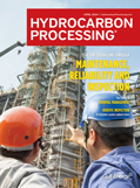Environment & Safety
Reaction control for hydrotreatment of bio-based oils in renewable diesel production
Over the past few years, the carbon footprint of the transportation industry has drawn attention as an area where much can be done to reduce greenhouse gas emissions.
Editorial Comment: Celebrating the technologies and people in the global hydrocarbon processing industry
On October 11, Gulf Energy Information celebrated the inaugural Gulf Energy Information Excellence Awards.
Executive Viewpoint: Overcoming challenges to build a scalable, reliable clean-H2 economy
The success of the energy transition hinges on creating a sustainable, reliable and affordable energy system for all.
Ukraine says oil refinery hit, power lines damaged in Russian drone attack
A Russian drone attack set ablaze the Kremenchuk oil refinery in central Ukraine and knocked out power supply in three villages, while falling debris from downed drones damaged railway power lines in a nearby region.
Venezuela's main refining complex running at 10% of capacity after two CDUs shutdown
Venezuela's largest refining complex, the 955,000-bpd Paraguana Refining Center, was operating at about 10% of capacity after two CDUs were shutdown due to a fire and lack of feedstock.
Fire at Afipsky oil refinery near Novorossiisk put out
A fire that broke out at the Afipsky oil refinery in Russia's Krasnodar region was promptly extinguished, the region's emergency security authorities said after social media reports of powerful blasts shaking the refinery.
Petoskey Plastics receives NOL from FDA for food-contact PCR-LLDPE
Petoskey Plastics has received a No Objection Letter from the U.S. Food and Drug Administration confirming the capability of its secondary recycling process to produce post-consumer recycled linear, low-density polyethylene material that is suitable for food-contact applications.
Technip Energies has complied at all times with applicable sanctions in relation to the Arctic LNG 2 Project
As of February 24, 2022, the date of the invasion of Ukraine, Technip Energies was overseeing the Arctic LNG 2 project in Gydan, northern Russia. The contract, awarded in 2019, covered engineering, equipment procurement and the construction of three LNG trains.
Saudi Aramco CEO: COP28 should focus on cutting fossil fuel emissions, not output
The chief executive of oil giant Saudi Aramco, said on Tuesday this year's COP28 U.N. climate conference should focus on cutting emissions from hydrocarbons, rather than reducing their production.
Discover Clariant’s new Ceridust 8170 M PTFE-free texturing agent for powder coatings
Rising concerns about the impact of PFAS on human health and the environment have led to a growing demand for PTFE alternatives. As part of this trend, Clariant has launched Ceridust 8170 M, a PFAS/PTFE-free agent with texturing effects for Architectural Powder Coatings.

- Vertex Energy pauses renewable diesel output to switch back to fossil fuels, citing macroeconomic woes 5/10
- Citgo Petroleum reports Q1 profit of $410 MM 5/10
- Golden Pass LNG in discussions with contractor, may delay startup 5/10
- SAFFiRE Renewables biofuel pilot plant to be developed in Kansas 5/10
- EBRD backs Ukraine's green biofuels project with €60-MM loan 5/10
- Russia's refined oil product exports to Singapore to hit highest this year in May 5/10




